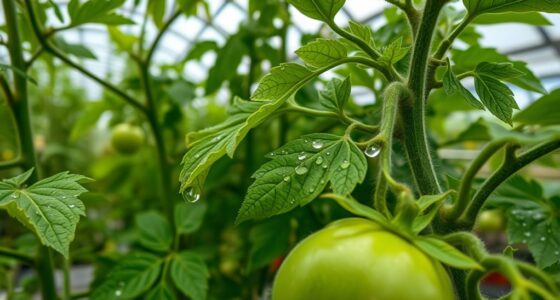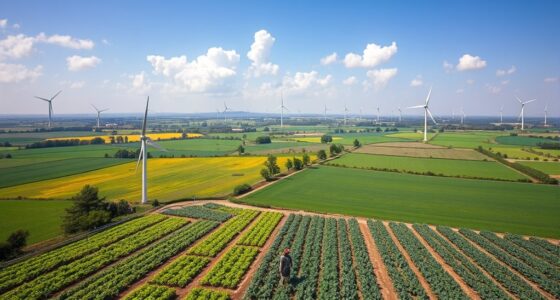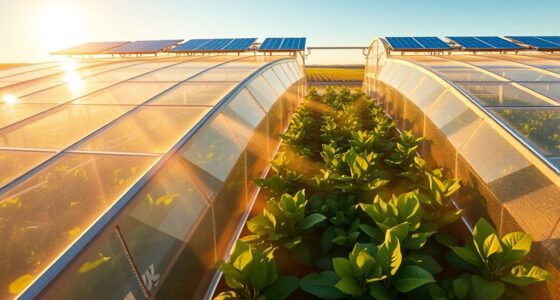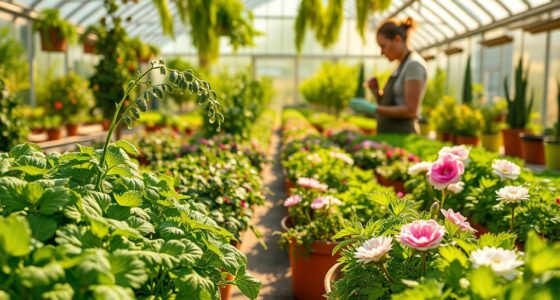By adopting multi-layer cropping, you can substantially increase your land’s productivity by stacking different crops vertically, making the most of limited space. Grow tall crops like corn or beans as your upper layer, while planting shorter leafy greens or root vegetables underneath. This approach maximizes yields, diversifies your harvest, and boosts efficiency. If you want to discover how to implement these strategies and triple your crop output, continue exploring these simple yet effective methods.
Key Takeaways
- Multi-layer cropping maximizes land use by stacking crops vertically, increasing overall productivity within limited space.
- Vertical integration of tall, mid-level, and ground-cover plants enables multiple harvests and diversifies income streams.
- Growing compatible crops with staggered schedules optimizes space, reduces resource competition, and boosts yields.
- Proper planning with supports, spacing, and pruning prevents shading and overcrowding, ensuring healthy crop development.
- Implementing multi-layer cropping creates a resilient, sustainable farming system that can triple yields from a single plot.

Have you ever wondered how farmers maximize land use and boost productivity? One effective method is multi-layer cropping, where you grow different crops at different heights within the same space. This approach allows you to make the most of every inch of your land, increasing yields without needing more acreage. By stacking crops vertically, you can produce multiple harvests from a single plot, making your farm more efficient and profitable. This technique hinges on understanding how to manage various plant types so they coexist without competing excessively for resources.
Vertical integration plays a pivotal role here. Instead of relying solely on a single crop, you can incorporate various layers—such as tall canopy plants, mid-level vegetables, and ground-cover crops. This integration not only maximizes space but also helps in managing pests and diseases, as a diverse crop environment is less vulnerable to widespread problems. Plus, vertical integration allows you to stagger planting and harvesting times, spreading out labor and income, and reducing risks associated with crop failure.
Vertical integration maximizes space, manages pests, and spreads labor through diverse crop layers.
Crop diversification is another key component of multi-layer cropping. By planting different types of crops, you create a resilient system that adapts to changing weather patterns, pests, and market demands. For instance, you might grow taller corn or beans as the upper layer, while planting shorter leafy greens or root vegetables underneath. This diversity ensures that if one crop struggles, others can compensate, stabilizing your overall yield. Moreover, crop diversification can improve soil health, as different plants draw nutrients differently, reducing the need for chemical inputs and fostering sustainable farming practices.
Implementing multi-layer cropping requires careful planning. You need to select compatible plants that have similar water and sunlight needs, and guarantee the taller crops don’t shade out the shorter ones excessively. Proper spacing and pruning are essential to prevent overcrowding and maintain airflow. Using trellises or vertical supports can help in managing taller crops and keep everything organized. Also, understanding each crop’s growth cycle allows you to schedule planting and harvesting efficiently, ensuring continuous productivity.
Ultimately, multi-layer cropping is about working smarter with your land. By combining vertical integration and crop diversification, you create a dynamic, productive system that yields more in less space. It’s an approach that not only boosts your farm’s output but also promotes sustainability and resilience. With some strategic planning, you can turn a single plot into a multi-story farm, tripling your productivity and making the most of every square foot you have.
Frequently Asked Questions
What Are the Best Crop Combinations for Multi-Layer Cropping?
When choosing crop combinations for multi-layer cropping, you should focus on companion planting and crop rotation. Select crops that complement each other, like tall beans with low leafy greens, to maximize space and nutrients. Rotate crops yearly to prevent pests and soil depletion. This strategy helps you optimize yield, improve soil health, and create a balanced ecosystem, making your multi-layer system productive and sustainable.
How Much Initial Investment Is Required to Start Multi-Layer Cropping?
Starting on multi-layer cropping is like planting seeds of future abundance. You’ll want to do a thorough cost analysis upfront, considering equipment requirements like specialized tools, irrigation systems, and planting materials. Initial investments vary based on farm size and crop choices, but expect to allocate funds for soil preparation and infrastructure. While the upfront costs may seem significant, the long-term gains in yield and efficiency make it a worthwhile endeavor.
What Are the Common Pests and Diseases in Multi-Layer Systems?
In multi-layer systems, pest management and disease prevention are vital. You’ll often encounter pests like aphids, beetles, and caterpillars, which can spread diseases or damage crops. To keep these issues at bay, regularly inspect plants, use integrated pest management techniques, and promote natural predators. Proper sanitation and crop rotation also help prevent disease buildup. Staying vigilant and proactive ensures your multi-layer system remains healthy and productive.
How Does Multi-Layer Cropping Impact Soil Health Over Time?
You might notice that multi-layer cropping improves soil health by enhancing nutrient cycling and reducing soil erosion. With diverse plant roots, nutrient absorption becomes more efficient, replenishing the soil naturally. As plants grow at different levels, they protect against erosion by anchoring the soil. Over time, this system promotes healthier, more resilient soil, supporting sustainable farming practices that boost productivity while preserving the land for future crops.
Can Multi-Layer Cropping Be Adapted for Small Urban Gardens?
You can definitely adapt multi-layer cropping for small urban gardens through vertical integration and container gardening. By stacking plants vertically using shelves or trellises, you maximize limited space and create multiple layers. Container gardening allows you to easily manage soil and watering, making it practical for urban settings. This approach boosts your yield, promotes efficient use of space, and adds diversity to your garden, all within a compact area.
Conclusion
By embracing multi-layer cropping, you’re planting seeds of abundance that reach toward the sky, symbolizing growth and limitless potential. Just as a canopy shelters and nurtures beneath its layers, your fields become a tapestry of life, flourishing in harmony. With each season, you’re not just harvesting crops—you’re cultivating resilience and hope. Let your land be a tribute to ingenuity, where every layer symbolizes your dedication to a bountiful future.










